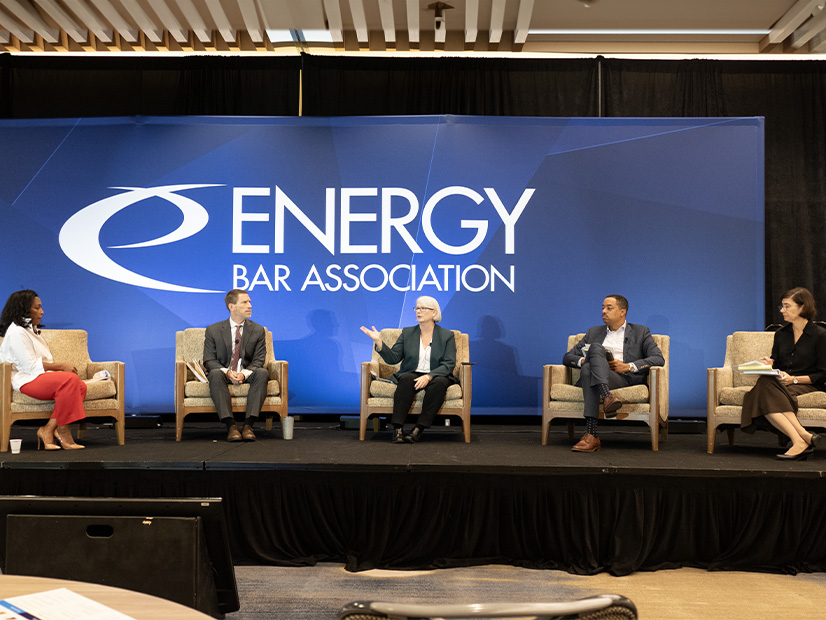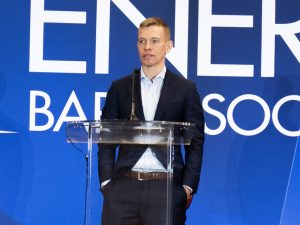
WASHINGTON — Affordability and reliability can be maintained as the grid transitions to clean energy if the right decisions are made, FERC General Counsel Matthew Christiansen said Wednesday at the Energy Bar Association’s Mid-Year Energy Forum.
The technological trends are all moving toward new forms of energy including wind, solar and storage, with other possible technologies including advanced nuclear, long-duration storage and carbon capture just around the bend. That is coupled with strong policy certainty after the Inflation Reduction Act passed last year, and state laws that have been enacted in the previous decade, said Christiansen.
“I think we also — this is every bit as important — have a good sense of the challenges that come with that,” he added. “I think a lot of people are justifiably excited about the changes that are underway. But at the same time, I think it’s really important not to undersell the challenges that are going to go with those changes.”
FERC and Christiansen’s “clients” — its commissioners — have a chance to make decisions now that will ensure a reliable and affordable supply of power even as the grid undergoes significant changes. That window is not narrow, but it is also not open-ended.
While planning to meet the highest hour of demand on the hottest day of the year is not as easy as it sounds, it is easier than maintaining reliability on the changing grid, said Christiansen. The new resources bring some expected unavailability (solar will drop off as the sun sets) and some unexpected, such as the wind not blowing or cloudy conditions lasting for days, he said.
“As if that weren’t enough, they’re taking place against the backdrop of an increased incidence of extreme weather, which is due in large part to climate change,” he added. “So, we have as big a reliability challenge that I think we’re going to have to manage, at least at any point that I’m aware, in the history of the industry. I don’t think that challenge is even remotely close to insurmountable.”
Identifying the specific challenges that the industry faces and then figuring what is needed to ensure the grid can handle those reliably is the main job of FERC and others overseeing the transformation, said Christiansen.
“So, let’s be really specific,” Christiansen said. “Let’s go out and procure those things using our regulatory constructs — markets where we have them — so that we know that we have the specific tools that we need.”
Doing that will ensure reliability, but affordability is almost more impactful, he added.
“In my view, the best way to ensure that we have those services when we need them, and that we have them at a price that we can afford as customers, is to harness the benefits of competition to ensure that everyone is competing to provide those services,” Christiansen said.
Washington state is one of those that has moved to decarbonize its power industry, requiring net-zero emissions by midcentury, and that has turned the Utilities and Transportation Commission from a purely rate-setting board to one that also implements policy, said Commissioner Ann Rendahl.
The UTC only oversees the investor-owned utilities in the state, not the dozens of public utilities that are all preferred customers of Bonneville Power Administration and benefit from a higher share of its emissions-free hydroelectricity. The private utilities rely more on fossil fuel than those publicly owned firms.
“So, it’s a lot of rate pressure,” Rendahl said. “And we’re trying to mitigate that rate pressure at the same time as we’re implementing this new thing of energy justice for the customers, which is not something we have previously done. It’s very important.”
D.C. has similar goals, but with a very different backdrop of just one utility, Pepco, which must import almost all of its power from other jurisdictions in PJM as the dense city lacks any central-station generation, said Public Service Commission Chair Emile Thompson.
“We are, you know, for the most part at the mercy of our RTO, PJM,” Thompson said. “And PJM’s mix right now is about 4% renewable. And so, for us to get to 100% renewable in D.C., what that most likely is going to reflect is renewable energy credits, which is not really what the legislature wants.”
Thompson said another disconnect happens on the natural gas side when people ask why the PSC cannot just order Washington Gas to stop selling the fuel in the district. The issue there is the firm has a federal charter to sell natural gas in the district, and federal law outweighs any law that the D.C. Council might pass, he said.
Maryland is going through the same shifts, with a policy to electrify most of its natural gas demand, but that long-term goal has not filtered down to the planning at its local delivery companies, said People’s Counsel David Lapp.
The state has retail competition for natural gas, so utilities are indifferent to the amount of fuel flowing through their systems, but they are hyper-focused on that delivery infrastructure and have major investment plans in it in the coming decades, Lapp said. They spend $1 billion a year on their systems now, and that is expected to go up to $3 billion by 2050, he said.
“This is of great concern to customers, and we think it’s inconsistent with the state’s climate goals,” Lapp said.
With state and federal incentives for electrification, more of those customers will leave natural gas service as their bills rise, with fewer left behind to cover those costs. Those customers will tend to be the ones who can least afford it, he said.
“The people left on the gas system are going to be the people who can’t get off the gas system, and that’s lower-income customers,” Lapp said. “Eventually we think this will lead to stranded costs.”
The utilities would still be able to recover those stranded costs even if customers leave the natural gas system in droves, he added. In a competitive system, those investments would not be made, and regulation is supposed to stand in for the market in such cases, so the People’s Counsel has asked the PSC in a petition to engage in comprehensive planning of the gas system.
“Rates can’t be just and reasonable if they are based on an assumption that gas use is going to continue in five, 10, 20, 50 to 60 years, as it is occurring today. The state can’t meet its climate goals to accomplish that, and customers are at risk.”



